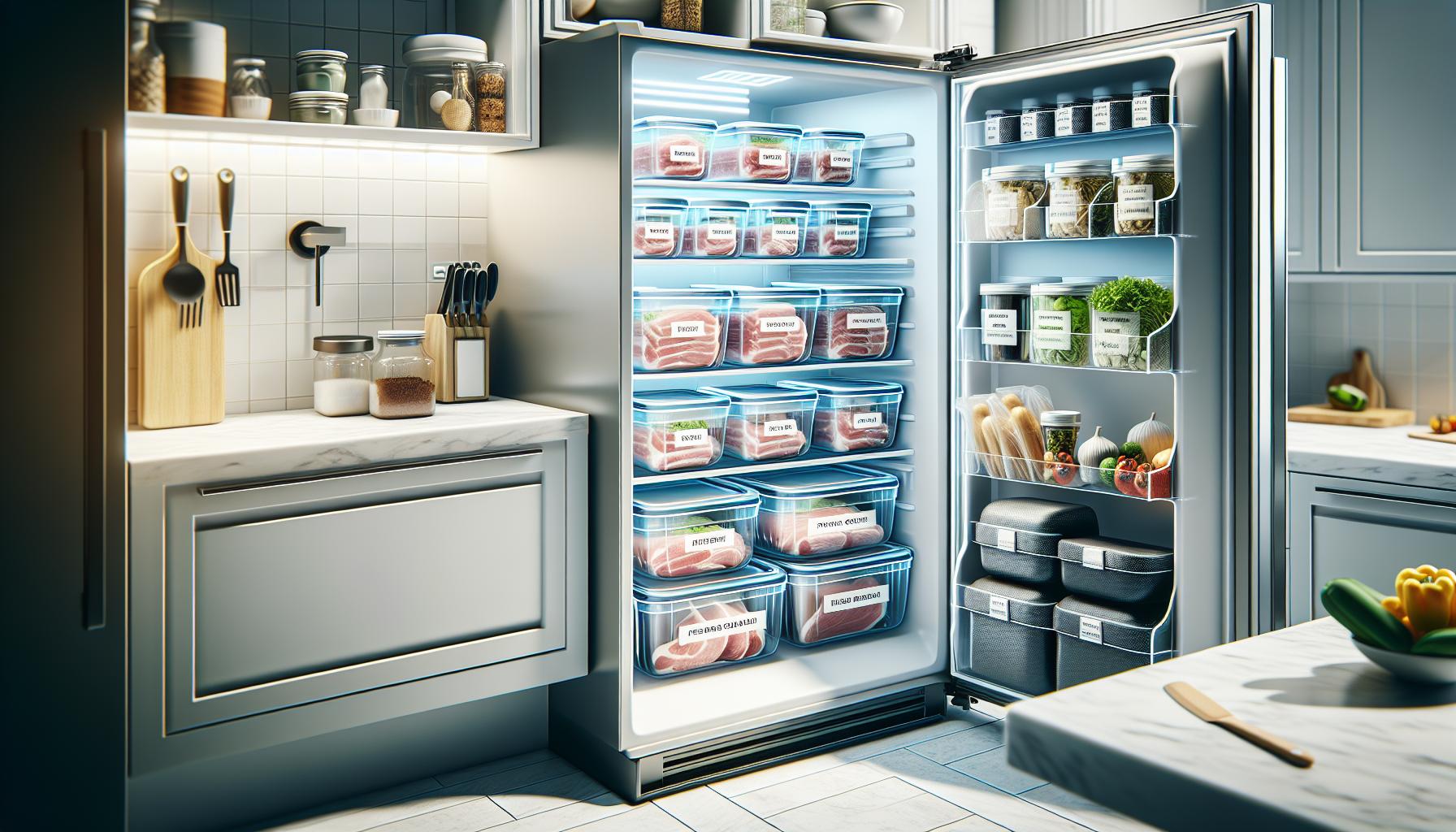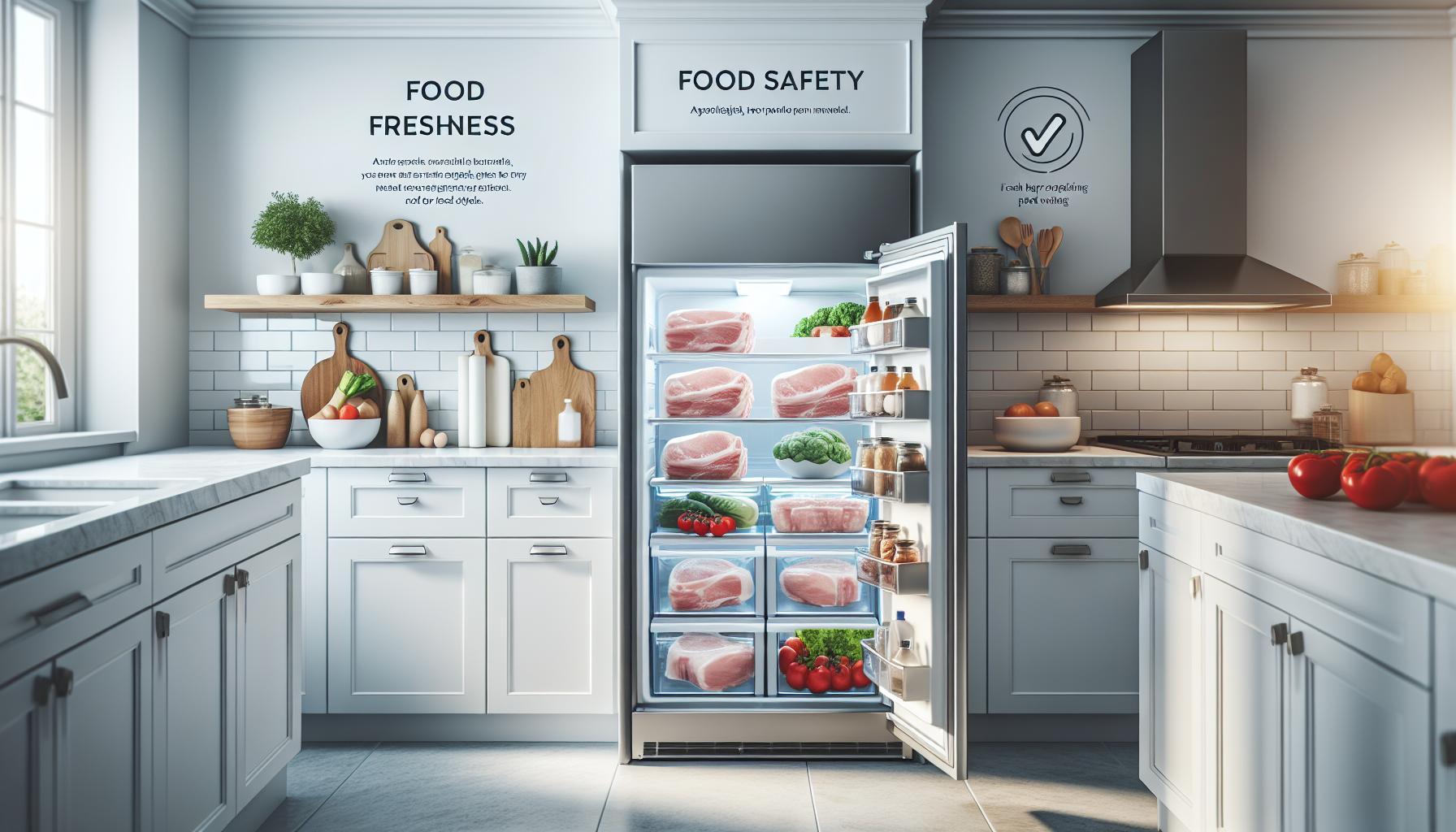Pork chops are a beloved staple in many kitchens, but knowing how long they last in the fridge is crucial for both safety and quality. Improper storage can lead to foodborne illnesses or wasted food, which no one wants. Understanding the shelf life of pork chops not only helps you maximize their freshness but also ensures that you’re serving safe meals to your loved ones.
In this guide, we’ll explore the best practices for storing pork chops and the specific timeframes they should be kept in the refrigerator. Whether you’re a seasoned cook or just starting out, having this knowledge will empower you to make informed decisions while reducing food waste. Keep reading to discover how to keep your pork chops at their best!
How Long Do Pork Chops Last in the Fridge?
Pork chops are a popular choice for many meals, but it’s essential to know how long they can safely be stored in the refrigerator to maintain their quality and prevent foodborne illness. Generally, raw pork chops can last in the fridge for 3 to 5 days. If they’ve been cooked, they should ideally be consumed within 3 to 4 days after being placed in the refrigerator. Ensuring that pork chops are stored correctly will help extend their freshness and safety.
For optimal storage, it’s crucial to keep pork chops in their original packaging or wrap them tightly in plastic wrap or aluminum foil. This prevents exposure to air, which can lead to freezer burn or spoilage. Placing them in a sealed container can also help contain any potential odors and maintain their moisture. To ensure freshness, always store pork chops at or below 40°F (4°C), the recommended refrigerator temperature, and place them on the bottom shelf to avoid cross-contamination from other foods.
To confirm the freshness of pork chops, be vigilant for signs of spoilage, such as an off odor, slimy texture, or discoloration. If any of these signs are present, it’s best to discard them rather than take any risks. Proper handling and storage not only keep your pork chops safe but also enhance the flavor and texture of your meals.
Understanding Pork Chops: Types and Freshness
Pork chops are a beloved staple in many kitchens, but understanding their types and freshness can significantly enhance your cooking experience and food safety. There are several varieties of pork chops, including loin chops, rib chops, and sirloin chops, each varying in tenderness and flavor. Loin chops, for example, are often the most tender and can be found bone-in or boneless, making them a versatile choice for grilling or frying. Conversely, rib chops, which come from the rib section, may have more fat and a fuller flavor, while sirloin chops are leaner and can be slightly tougher, making proper cooking techniques essential for optimal tenderness.
When assessing the freshness of pork chops, it’s crucial to consider several factors. First, the date of purchase plays a significant role; ideally, pork chops should be labeled with a sell-by or use-by date. Once bought, they can last in the refrigerator for only about 3 to 5 days. To ensure the best quality, always check that the chops were stored correctly before you bought them and that your refrigerator is set to at or below 40°F (4°C). Fresh pork should have a light pink color, with little to no odor; if anything smells off or the color appears dull or grayish, it’s a sign to discard them.
To maximize the freshness of your pork chops, proper handling is essential right from the start. Avoid letting pork chops sit out for extended periods and always return any unused portions back to the cold as quickly as possible. If you need to extend their life, consider freezing them as soon as you buy them. When sealed properly in airtight packaging, frozen pork chops can last for several months, maintaining their quality for when you’re ready to cook them. This prevents waste and ensures that you always have high-quality ingredients on hand for your meals.
Optimal Storage Conditions for Pork Chops
To keep pork chops at their best quality and ensure food safety, it’s essential to store them under optimal conditions. The refrigerator is the most suitable environment for pork chops, where temperatures should consistently remain at or below 40°F (4°C). This helps inhibit bacterial growth and maintain the meat’s freshness. When storing, always place pork chops on a plate or in a shallow container to catch any juices that might escape, which can help keep other foods in the fridge safe from contamination.
Another key point is to ensure that the pork chops are properly wrapped. Use airtight packaging, such as resealable plastic bags or plastic wrap, to minimize exposure to air. Vacuum sealing is an excellent choice if you’re looking to extend their life even further. For those who plan to use their pork chops within a few days, simply placing the original packaging in the fridge is acceptable, but if you think they will sit longer, it’s prudent to transfer them to a more secure container.
For those considering bulk purchases or wanting to keep the pork chops for longer, freezing is a viable option. It is best to freeze pork chops as soon as possible after purchase, ensuring they are wrapped tightly in plastic wrap and then placed in a freezer-safe container or bag. Properly frozen pork chops can maintain their best quality for 4 to 6 months, although they are safe to consume beyond that timeframe if stored correctly. Always remember to label your packages with the date to keep track of how long they have been stored.
By following these storage guidelines, you can maximize both the freshness and safety of your pork chops, allowing you to enjoy delicious meals without worry.
Signs of Spoilage: When to Discard Pork Chops
Pork chops are a flavorful and versatile addition to any meal, but ensuring their safety is paramount. Spoilage can happen quickly when they are stored improperly, and knowing the signs of spoilage can make a significant difference in preventing foodborne illnesses. Understanding these signs helps you maintain both the quality and safety of your pork chops.
One of the primary indicators that pork chops have gone bad is their color. Fresh pork should have a pink hue, while spoiled pork tends to take on a gray, brown, or greenish tint. If you notice any dark spots or discoloration, it’s safest to discard the meat. Additionally, the texture can also offer clues. Fresh pork should feel moist but not slimy. If the surface becomes sticky or tacky, that’s a strong sign that the pork has begun to spoil and should not be consumed.
Another critical sign of spoilage is the smell. Fresh pork generally has a mild, slightly sweet aroma. If you detect a sour or ammonia-like odor, it’s best to err on the side of caution and throw it away. Always trust your nose; if something smells off, it probably is. Lastly, safety guidelines suggest being cautious with the storage time as well. Pork chops can be kept in the refrigerator for only 3 to 5 days. Beyond this timeframe, even if they look and smell fine, the risk of harmful bacterial growth increases significantly.
By recognizing these signs of spoilage, you can protect yourself and your loved ones from potential health risks. When in doubt, it is always wiser to discard rather than risk a foodborne illness. Ensuring that your pork chops are fresh not only enhances your meals but also makes for a healthier dining experience.
How to Properly Store Leftover Pork Chops
Leftover pork chops can be a delightful addition to future meals, but proper storage is crucial to maintain their freshness and safety. After cooking, pork chops should be cooled quickly and stored correctly to prevent bacterial growth. Start by letting the pork chops sit at room temperature for no more than two hours; this limits the time they spend in the “danger zone” where bacteria can flourish.
Once the pork chops have cooled, wrap them tightly in aluminum foil or plastic wrap, or place them in airtight containers. This prevents exposure to air, which can lead to freezer burn and spoilage. When stored correctly, cooked pork chops can safely last in the refrigerator for about 3 to 4 days. It’s best to label the containers with the date they were cooked to ensure you use them within this timeframe.
For optimal refrigerator storage, it’s ideal to keep the temperature at or below 40°F (4°C). Remember that the back of the refrigerator is generally the coldest area, making it the safest spot for storing your goodies. When you’re ready to enjoy them again, reheat the pork chops to an internal temperature of 165°F (74°C) to ensure any potential bacteria are eliminated.
If you anticipate that you won’t be able to consume the leftovers within a few days, consider freezing them. Frozen pork chops can last up to six months, though for the best quality, aim to use them within three months. When freezing, wrap the pork chops tightly in freezer-safe materials or use a vacuum sealer to prevent air exposure. By following these simple guidelines, you can maximize the freshness and safety of your leftover pork chops, turning them into a delicious meal at a moment’s notice.
Impact of Cooking Methods on Shelf Life
Cooking methods can significantly influence the shelf life of pork chops, affecting not only taste and texture but also their safety after cooking. Different preparation techniques lead to varying levels of moisture retention, fat content, and the presence of potential contaminants. Understanding these nuances is crucial for maximizing freshness and ensuring food safety after your meal.
When pork chops are grilled or pan-seared, for instance, they tend to lose more moisture compared to when they are baked or braised. Less moisture can potentially enhance the texture but might also lead to a shorter shelf life, as drier meats can lead to quicker staling and changes in flavor. It is essential to consider how meat is cooked when planning to store leftovers. Pork chops that are cooked to an internal temperature of at least 145°F (63°C) and then allowed to rest for three minutes before slicing will not only be safe to eat but may also retain better quality when stored.
Additionally, cooking methods that incorporate oils or sauces can influence how long pork chops remain palatable. Fat can act as a barrier against oxidation, which can help prolong freshness. However, any residual sauces can introduce moisture that may promote bacterial growth if not stored correctly. Accordingly, it’s advisable to store leftovers in airtight containers after they have cooled properly to prevent spoilage.
To maximize safety and quality, consider these storage specifics based on cooking methods:
- Grilled or Seared Pork Chops: Best used within 3-4 days in the fridge due to higher moisture loss and potential flavor changes.
- Baked or Braised Pork Chops: Can last up to 4 days while maintaining better moisture content and flavor.
- Pork Chops with Sauces: Store immediately in airtight containers to limit exposure to air and moisture that may encourage spoilage.
By recognizing the impact of cooking methods and following proper storage protocols, you can enjoy your pork chops while ensuring they remain safe and delicious for subsequent meals.
Safety Guidelines: Thawing and Reheating Pork Chops
Thawing pork chops properly is crucial not just for safety, but also for maintaining their texture and flavor. The safest way to thaw frozen pork chops is to transfer them from the freezer to the refrigerator, allowing them to defrost gradually. Depending on the thickness, this can take anywhere from several hours to overnight. During this time, it’s important to keep the pork chops in a shallow container to catch any drippings and prevent cross-contamination with other foods. Once thawed, pork chops should be cooked within 3-5 days for optimal freshness and safety.
If you’re short on time, the microwave is a fast thawing method, but care must be taken to avoid partially cooking the meat. For even thawing, use the microwave’s defrost setting for the weight of the pork chops and follow up by cooking them immediately. It’s essential never to thaw pork chops at room temperature, as this creates an ideal environment for harmful bacteria to grow.
When it comes to reheating pork chops, the key is to bring them back to a safe internal temperature of 165°F (74°C) to ensure any potential bacteria are eliminated. This can be effectively achieved using an oven, stove, or microwave. To preserve moisture during reheating, consider covering the pork chops with foil if using an oven, or adding a splash of broth or water if you’re microwaving them. Maintaining proper heating practices not only safeguards your health אבל will also enhance the overall dining experience by keeping the pork chops juicy and flavorful.
By following these guidelines, you can ensure that your thawed and reheated pork chops are not only safe to eat but also delicious and enjoyable.
Extending Freshness: Tips for Freezing Pork Chops
Freezing pork chops is an excellent way to extend their shelf life while preserving their flavor and texture. With proper techniques, you can ensure that your pork stays fresh and ready for use, even months down the line. The key to successful freezing lies in optimal packaging, temperature control, and awareness of storage times.
To begin with, ensure that your pork chops are fresh before freezing. Ideally, they should be chilled promptly after purchasing, and you should freeze them as soon as possible. Packaging is crucial; use airtight packaging methods like vacuum sealing or heavy-duty freezer bags. If you opt for freezer bags, make sure to remove as much air as possible to prevent freezer burn, which can affect quality. Additionally, consider wrapping the chops in plastic wrap or aluminum foil before placing them in a freezer bag for added protection.
It’s essential to label each package with the date of freezing. For pork chops, the recommended freezer storage duration for optimal quality is 4 to 6 months. While the USDA states that frozen foods can be stored indefinitely at 0°F (-18°C) or below for safety, the quality may decline over time, resulting in dryness or a change in texture. To maximize freshness when ready to use, thaw pork in the refrigerator for safety and flavor retention, using the methods discussed previously.
Upon removing pork chops from the freezer, inspect them visually and by smell. If any signs of freezer burn or off-odors are detected, it’s best to discard them. By following these storage guidelines, you can enjoy delicious pork chops at your convenience without compromising safety or quality.
Common Myths About Pork Chop Storage
When it comes to storing pork chops, several myths can lead to confusion and potentially unsafe practices. One prominent misconception is that meat can last indefinitely if frozen. While it is true that freezing keeps pork safe indefinitely at 0°F (-18°C) or lower, the quality diminishes over time. For pork chops, the recommended storage duration in the freezer for optimal quality is 4 to 6 months. After this period, though still safe, they may develop off-flavors and textures due to freezer burn or drying out.
Another common myth is that pork can be safely stored in the refrigerator for longer than the advised time frame. Many believe that as long as pork chops appear fine, they are safe to eat. However, pork should only be stored in the fridge for up to 3 to 5 days after purchase. Beyond this time, even if there are no visible signs of spoilage, harmful bacteria can proliferate, leading to foodborne illnesses. Always trust your senses-if the meat has an off smell or a slimy texture, it’s time to discard it.
Some people also think that cooking spoiled pork will make it safe to eat. This notion is dangerous and incorrect. Cooking can kill some bacteria, but toxins produced by certain pathogens may remain and cause illness. To ensure safety when preparing pork, always check its freshness before cooking, and adhere to recommended cooking temperatures-145°F (63°C) for pork chops, followed immediately by a resting period of three minutes to ensure any harmful bacteria are effectively eradicated.
For better storage practices, consider the following essential guidelines:
- Keep pork chops wrapped tightly to limit exposure to air, which can cause freezer burn.
- Label items with purchase or freezing dates to keep track of freshness.
- Use a thermometer to ensure your refrigerator is at or below 40°F (4°C) to maintain safe storage conditions.
By dispelling these myths and following proper guidelines, you can maximize freshness, safety, and quality in your pork chop storage.
Recommended Best Practices for Food Safety
Ensuring the safety and quality of pork chops is essential for both health and culinary success. Start by understanding that proper storage practices can significantly extend the shelf life of your meat while minimizing the risk of foodborne illness. For raw pork chops, refrigeration is optimal for only 3 to 5 days. If you need to keep them longer, consider freezing them, as this preserves quality for up to 4 to 6 months.
To maximize freshness, always store your pork chops in their original packaging if possible, or transfer them to airtight containers or vacuum-sealed bags to limit exposure to air and moisture. Label each package with the date of purchase or freezing to help track freshness. Keep your refrigerator temperature at or below 40°F (4°C) to inhibit bacterial growth, and invest in a refrigerator thermometer to verify your appliance’s accuracy. Remember to store pork chops on the bottom shelf of the fridge to prevent drippings from contaminating other foods.
When preparing to cook or reheat pork chops, ensuring that they reach a safe internal temperature of 145°F (63°C) is crucial. Use a meat thermometer to confirm the temperature, and allow the meat to rest for three minutes before serving; this resting period allows juices to redistribute while killing any remaining bacteria. For leftovers, consume or freeze within 3 to 4 days to maintain safety and quality.
By adhering to these best practices, you can enjoy delicious pork chops with confidence, knowing that you’ve prioritized food safety and freshness at every step of the process.
Pork Chop Storage and Meal Prep Ideas
Storing pork chops properly can enhance not only their shelf life but also your meal prep strategies, ensuring you have delicious and safe meals ready whenever you need them. When considering how to effectively store pork chops, think about leveraging both short-term and long-term storage solutions tailored to your cooking needs.
For fresh pork chops, utilize airtight containers or vacuum-sealing bags to minimize air exposure and maintain flavor. It’s ideal to keep raw pork chops in the refrigerator for no more than 3 to 5 days. To extend their usability, consider creating a meal prep plan where you cook your pork chops ahead of time. Cooked pork chops can be stored in the refrigerator and should be consumed within 3 to 4 days. You can also repurpose leftovers into various dishes such as stir-fries, sandwiches, or salads, providing versatile meals with minimal effort.
Additionally, if you purchase pork chops in bulk, freezing is an excellent option. Raw pork chops can be kept in the freezer for up to 4 to 6 months. To facilitate meal prep, you might pre-season the chops or marinate them before freezing, which not only saves time later but also enhances flavor once cooked. Remember to label each package with the date and type of seasoning to keep track of their freshness.
Common Storage Tips
- Store raw pork chops on the bottom shelf of the fridge to prevent cross-contamination.
- Flash freeze individual chops on a baking sheet before transferring them to airtight containers to avoid them sticking together.
- If cooking a large batch, consider slicing some chops for stir-frys and keeping others whole for grilling to add variety to your meals.
- Always use a meat thermometer to check that your pork reaches an internal temperature of 145°F (63°C) for safety during cooking.
By implementing these simple yet effective storage and meal prep strategies, you can enjoy the freshness of your pork chops while maximizing their usability throughout the week. This ensures that your meals are not only safe but also flavorful and satisfying.
Frequently Asked Questions About Pork Chop Freshness
Did you know that proper storage can make a significant difference in the freshness and safety of your pork chops? For those wondering how long pork chops last in the fridge, understanding the right storage practices can help maximize their shelf life and maintain their quality. Raw pork chops typically remain safe for consumption in the refrigerator for about 3 to 5 days, while cooked pork chops are best consumed within 3 to 4 days after cooking.
One common question is whether it’s safe to eat pork chops after the recommended storage periods. If your pork chops have been in the refrigerator longer than the specified time, it’s wise to inspect them closely. Signs of spoilage include off smells, discoloration, or a slimy texture. In these cases, it’s better to err on the side of caution and discard them. Proper labeling can help you keep track of how long your chops have been stored, ensuring you consume them while they’re still fresh.
Another frequent inquiry pertains to freezing pork chops. When raw, they can safely be stored in the freezer for about 4 to 6 months, while cooked pork can last for 2 to 3 months. To maintain quality, consider vacuum-sealing or wrapping them tightly in plastic before freezing. You can also pre-season them for added convenience. When it’s time to thaw, do so in the refrigerator, cold water, or for immediate use in the microwave, always ensuring they reach an internal temperature of 145°F (63°C) during cooking. This approach will not only enhance the safety of your meals but will also help preserve the flavor and texture of your pork chops.
FAQ
Q: How can I tell if pork chops have gone bad?
A: Signs that pork chops have spoiled include a sour smell, a slimy texture, and discoloration. If you notice any of these indicators, it’s best to discard the meat to avoid foodborne illnesses. Refer to our section on “Signs of Spoilage” for more details.
Q: What is the best way to store pork chops in the fridge?
A: Store pork chops in their original packaging or wrap them tightly in plastic wrap or aluminum foil. Make sure they are placed on the bottom shelf to prevent any juices from contaminating other foods. Check our “Optimal Storage Conditions for Pork Chops” section for more tips.
Q: Can pork chops be stored in the fridge after cooking?
A: Yes, cooked pork chops can be stored in the fridge for 3-4 days. Make sure to cool them down to room temperature before placing them in an airtight container. For more on leftover storage, see “How to Properly Store Leftover Pork Chops.”
Q: How long can I thaw pork chops in the fridge before cooking them?
A: Thawed pork chops can safely remain in the fridge for 3-5 days before cooking. Ensure they are kept at a consistent temperature of 35-40°F. For detailed instructions, check our “Safety Guidelines: Thawing and Reheating Pork Chops.”
Q: Is it safe to eat pork chops past their expiration date?
A: It is not advisable to consume pork chops past the expiration date. Always check for spoilage signs, even if the date has not yet passed. Refer to our “Signs of Spoilage” section for more information.
Q: How should I reheat leftover pork chops for best results?
A: Reheat leftover pork chops in the oven at 350°F until they reach an internal temperature of 165°F. This method helps retain moisture and flavor. For additional tips, see our “Safety Guidelines: Thawing and Reheating Pork Chops.”
Q: Can I freeze fresh pork chops for extended storage?
A: Yes, fresh pork chops can be frozen to extend their shelf life for 4-6 months. Ensure they are well-wrapped to prevent freezer burn. More freezing tips are found in our section, “Extending Freshness: Tips for Freezing Pork Chops.”
Q: What types of pork chops stay fresh the longest?
A: Bone-in pork chops generally stay fresh longer than boneless chops due to their moisture retention. Additionally, thicker cuts often last longer in storage. See “Understanding Pork Chops: Types and Freshness” for further insights.
To Conclude
Now that you understand how long pork chops last in the fridge and the importance of proper storage for maximizing freshness and safety, it’s time to take action! Remember, while pork chops can typically be stored for 3 to 5 days, their quality and safety greatly depend on how you handle them. For the best practices on keeping your meat fresh, check out our guide on safe food storage techniques and learn about the best ways to marinate pork for delicious flavors.
If you have any questions or concerns about your pork or other meats, don’t hesitate to reach out or leave a comment below. Join our community by signing up for our newsletter to receive the latest tips, recipes, and safety advice straight to your inbox. Explore our site for more valuable resources, and make sure your kitchen practices keep both flavor and safety at the forefront. Your beautiful meals deserve it!





